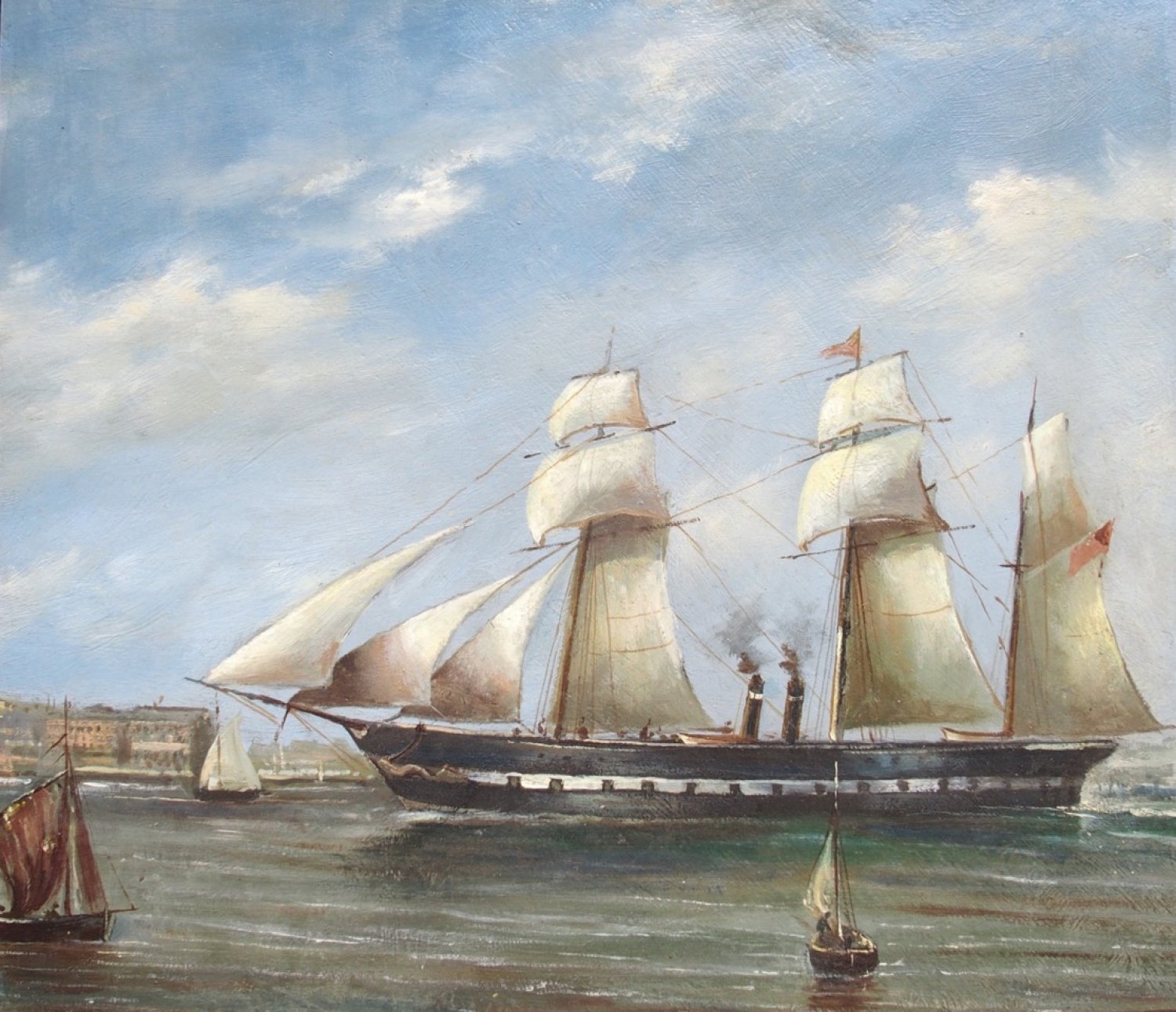Unknown
(The SS Antelope),
Oil on card
$5,500.00 including GST
Literature:
This work is accompanied by an original page from The Illustrated London News, Feb. 5, 1853, with an extensive article on the SS Antelope and an engraved portrait of the ship titled ‘“The Antelope” Australian Steam-Ship’
Original Huon Pine Veneered Frame
The SS Antelope arrived in Hobart on December 1853 (the Courier 17 December 1853) and although designed for 'The Australian Service' due to crew shortages caused by the Gold Rush, only worked the run, Hobart, Sydney, Adelaide Melbourne for a year or so. She was known as being luxuriously out- fitted.
The Antelope is shown under full sail, as she sails south past the warehouses of the Hunter Street Dock in Hobart.
Hunter’s Street
Hunter’s Island was connected to the mainland by a narrow sand spit which could be crossed at low tide but was waist deep at high tide. Until a permanent stone causeway was built between the island and the land passengers who disembarked their ship at Hunter’s Island but could not afford a boat ride to shore were often carried across the spit “piggy back” for a lesser fee. The causeway was completed in 1821 and became Hunter’s Street. Hunter’s Street still essentially follows the line of the original sand spit and stone causeway, while the island itself is more or less under the University of Tasmania Art School building.
Until other wharves were built in Sullivan’s Cove, Hunter’s Wharf was the place where most migrants disembarked at the end of their journey from Britain and also where most goods, for import or export, were loaded or unloaded from ships.
Buildings
Because most of the buildings in Hunter’s Street date back to the early 1820s they provide a continuous, tangible link to the precinct’s past.
The first buildings on Hunter’s Island were tents such as tents for stores and guards. These were rapidly replaced by timber structures. Once the causeway was completed in 1821 the easy movement of building materials and equipment meant that the merchants could build safer more durable sandstone structures with material from the nearby quarry. These included warehouses, residences, hotels and other buildings.
The SS Antelope was a very early (possibly the second) screw liner to visit Australia. In 1852 the liner Great Britain had come to Melbourne with 630 emigrants. At the time, there was great debate as the various benefits of sail and steam. Antelope was built specifically to challenge Marco Polo as the fastest vessel to Australia. She was built by Messrs. Millars and Thompson (The Golden Line) and “whatever capital could furnish, or skill suggest, has been applied with no less liberality than discrimination rendering her perfect in respect.
The Antelope was fitted out with the latest advancement including fire Hydrants, Admiralty boats (lifeboats), patent glass silver reflecting lights, , with six compartments, the latest Forrester engines(250 HP), displaying 1200 tons, keel length and a hold of 18 foot. 1200.
Sea trials took place in May, 1853, making 19 knots under steam and 11 to 12 knots under steam and sail, without any favorable wind.
She had a protracted voyage to Australia due to machinery problems, necessitating making port at Madeira, Rio de Janeiro and Cape Town. Due to limited space for coal, she could steam for 11 days only after leaving Cape Town. She was in Adelaide in early August, 1853.
She visited Port Phillip and Sydney, and by 3 January, 1854 was at George Town (The Tamar) for further repairs. She reached Hobart on 7 January, 1854, with part of her original cargo. The Steamer Antelope has arrived from Melbourne and Adelaide. She worked the Australian coast for a year or so, and in 1855 returned to Liverpool.
She sank in 1890 in a collision in the North Sea.


